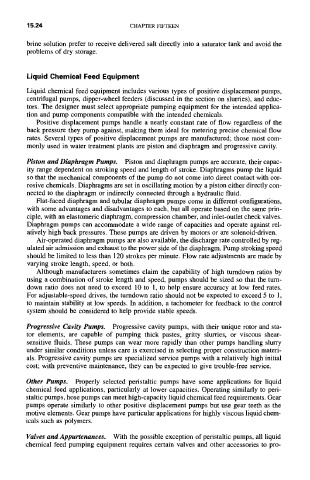Page 517 -
P. 517
15.24 CHAPTER FIFTEEN
brine solution prefer to receive delivered salt directly into a saturator tank and avoid the
problems of dry storage.
Liquid Chemical Feed Equipment
Liquid chemical feed equipment includes various types of positive displacement pumps,
centrifugal pumps, dipper-wheel feeders (discussed in the section on slurries), and educ-
tors. The designer must select appropriate pumping equipment for the intended applica-
tion and pump components compatible with the intended chemicals.
Positive displacement pumps handle a nearly constant rate of flow regardless of the
back pressure they pump against, making them ideal for metering precise chemical flow
rates. Several types of positive displacement pumps are manufactured; those most com-
monly used in water treatment plants are piston and diaphragm and progressive cavity.
Piston and Diaphragm Pumps. Piston and diaphragm pumps are accurate, their capac-
ity range dependent on stroking speed and length of stroke. Diaphragms pump the liquid
so that the mechanical components of the pump do not come into direct contact with cor-
rosive chemicals. Diaphragms are set in oscillating motion by a piston either directly con-
nected to the diaphragm or indirectly connected through a hydraulic fluid.
Flat-faced diaphragm and tubular diaphragm pumps come in different configurations,
with some advantages and disadvantages to each, but all operate based on the same prin-
ciple, with an elastomeric diaphragm, compression chamber, and inlet-outlet check valves.
Diaphragm pumps can accommodate a wide range of capacities and operate against rel-
atively high back pressures. These pumps are driven by motors or are solenoid-driven.
Air-operated diaphragm pumps are also available, the discharge rate controlled by reg-
ulated air admission and exhaust to the power side of the diaphragm. Pump stroking speed
should be limited to less than 120 strokes per minute. Flow rate adjustments are made by
varying stroke length, speed, or both.
Although manufacturers sometimes claim the capability of high turndown ratios by
using a combination of stroke length and speed, pumps should be sized so that the turn-
down ratio does not need to exceed 10 to 1, to help ensure accuracy at low feed rates.
For adjustable-speed drives, the turndown ratio should not be expected to exceed 5 to 1,
to maintain stability at low speeds. In addition, a tachometer for feedback to the control
system should be considered to help provide stable speeds.
Progressive Cavity Pumps. Progressive cavity pumps, with their unique rotor and sta-
tor elements, are capable of pumping thick pastes, gritty slurries, or viscous shear-
sensitive fluids. These pumps can wear more rapidly than other pumps handling slurry
under similar conditions unless care is exercised in selecting proper construction materi-
als. Progressive cavity pumps are specialized service pumps with a relatively high initial
cost; with preventive maintenance, they can be expected to give trouble-free service.
Other Pumps. Properly selected peristaltic pumps have some applications for liquid
chemical feed applications, particularly at lower capacities. Operating similarly to peri-
staltic pumps, hose pumps can meet high-capacity liquid chemical feed requirements. Gear
pumps operate similarly to other positive displacement pumps but use gear teeth as the
motive elements. Gear pumps have particular applications for highly viscous liquid chem-
icals such as polymers.
Valves and Appurtenances. With the possible exception of peristaltic pumps, all liquid
chemical feed pumping equipment requires certain valves and other accessories to pro-

